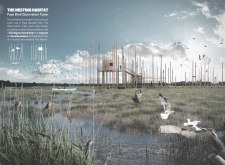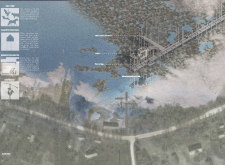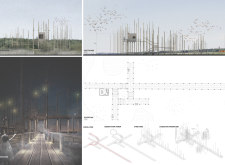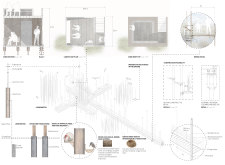5 key facts about this project
At its core, the Nesting Habitat functions as a dual-purpose structure. It not only facilitates bird watching but also incorporates features that support local fauna. The design prioritizes ecological sustainability, reflecting an understanding of the delicate balance between human activity and natural habitats. Carefully considered sightlines from the observation platform provide unobtrusive views of the surrounding ecology, enabling wildlife enthusiasts to observe bird behavior in their natural setting. This emphasis on observation promotes a deeper appreciation for nature and the importance of conservation efforts.
The architectural design consists of a series of elevated platforms supported by slender vertical poles, which evoke the imagery of reeds and grasses found within the wetlands. This design choice not only serves aesthetic purposes but also enhances the structural integrity of the tower while blending seamlessly with its environment. The use of wood as the main material further signifies the project's commitment to sustainability, as wood is a renewable resource that adds to the building's natural character. In addition to wood, aluminum is utilized for various structural components, offering durability and lightweight properties that are advantageous for this elevated construction, while concrete is employed for the foundational elements, ensuring stability where it is most needed.
Unique to this project are its integrated artificial nesting sites. These features have been introduced to foster a habitat for local birds, thereby enriching the relationship between the structure and its surrounding ecosystem. The architectural approach goes beyond mere observation; it embraces an educational aspect, encouraging visitors to recognize their role in the conservation of natural habitats. The layout of the tower encourages visitors to interact with this educational component, promoting an understanding of the local avifauna and the challenges they face.
Considerations for nighttime accessibility are also woven into the design. The illuminated features of the structure allow for safe exploration after dark, inviting visitors to witness the nocturnal activities of wildlife. This aspect demonstrates a forward-thinking approach, acknowledging that engagement with nature can occur at all times of the day, further enriching the visitor experience.
In exploring the Nesting Habitat, one can appreciate how architecture can serve as a conduit for environmental interaction. The thoughtful integration of materials, the functionality of various spaces, and the emphasis on wildlife habitats all work in unison to form a structure that is inherently respectful of its natural surroundings. This project stands as a testament to how design can foster a deeper connection between visitors and the environment, promoting both enjoyment and a sense of stewardship.
For those interested in gaining a more comprehensive understanding of the Nesting Habitat, an exploration of the architectural plans, architectural sections, and architectural designs will provide valuable insights into the project’s intent and execution. The innovative architectural ideas embedded within this project reveal a commitment to not only aesthetics but also functionality and ecological responsibility, demonstrating how architecture can serve as a bridge between people and the natural world.


























